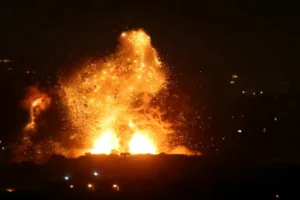Can the AU Deliver Pax Africana?
Addis Ababa, Ethiopia:
Last week in Addis Ababa, Ethiopia, African Union (AU) leaders celebrated the 50th anniversary of the Organisation of African Unity (OAU) – the AU’s predecessor. They spoke of the OAU’s leadership in past liberation struggles and offered lofty visions for the future.
But, in his final speech as AU assembly chairperson, Benin’s President Yayi Boni took a more critical look at the present.
Referring to France’s recent military intervention in northern Mali, he asked: “How can we understand that when danger threatened its very basis, Africa, which has the means to organise its own defence, continued to wait?”
Boni’s frustration speaks more broadly of the AU’s continued difficulty in achieving Pax Africana: a peace kept in Africa, by Africa.
Lax Africana?
In the last year, Africa has seen conflict in, amongst other places, Mali and the wider Sahel, the Sudans, the Democratic Republic of Congo (DRC), the Central African Republic, Somalia, and northern Nigeria. As a result, the AU is rethinking how it can ensure peace and security.
The major challenge for the AU’s peace and security architecture is funding. The current model of gathering Western donations and African troops has been relatively effective, but is slow and hard to maintain. The African Union Mission in Somalia (AMISOM) – one of the AU’s most successful operations to date – is in its sixth year, yet struggles for consistent funding.
Despite the AU’s offer of $50 million to its Mali mission (its first major financial contribution to such an undertaking), Jakkie Cilliers, executive director of the South African Institute for Security Studies, claims the financial problem will not go away soon. “Africa will never in the foreseeable future be able to fund large peacekeeping operations on its own”, he told Think Africa Press.
Nkosazana Dlamini-Zuma, the new chairperson of the AU commission, used the latest summit to call for a more holistic approach in achieving Pax Africana. In addition to urging the creation of an African standby force to quell conflicts, she pushed the AU to address the ‘root causes’ of conflict – poverty and poor governance. Without development, she said, there can be no peace.
Dakar to Djibouti: development dreams
The AU is beginning to implement programmes to address the conditions that drive conflict. Regarding poor governance, the AU is working towards legal frameworks to curtail unconstitutional changes of government and is establishing human rights courts on the continent.
The AU also tries to help governments reform through a voluntary evaluation system called theAfrican Peer Review Mechanism (APRM). The APRM is ten years old, and has had success identifying problems and offering recommendations to better address citizens’ needs.
But the APRM has few teeth to ensure its recommendations are carried out. For example, while the APRM recognised the potential for ethnic violence in the run-up to Kenya’s 2007 elections, groups still clashed in the absence of meaningful reform. Cilliers explained that the APRM is starting to move towards better monitoring and compliance, but for now its ability to affect good governance goes only as far as each member-state’s willingness to reform.
Development may be a bigger challenge for the AU because of the need for external capital. The AU’s main development ambitions are mostly expensive, long-term infrastructure projects. These include planned superhighways connecting Dakar to Djibouti and the Cape to Cairo. Such projects have powerful backers, including South African president Jacob Zuma who hopes to integrate economies within regions and across the continent.
But according to Andris Piebalgs, European Commission commissioner for development and EU delegate to the AU, the focus on massive infrastructure projects to integrate economies is not the best way to achieve Pax Africana. “There is a lot of talk about a Pan-African infrastructure”, he told Think Africa Press, “but really for it to work the main aspect is liberalisation of trade inside the African Union”. To that effect, the AU has proposed a continental free trade zone by 2017.
Scrambling Africa
In the meantime, however, the AU will have to focus on more immediate ways to maintain or enforce peace by putting boots on the ground.
The AU’s military record so far is mixed. Its first mission in Burundi in 2003 is credited with stabilising the country, and the ongoing Somalia mission has been tentatively successful. But an AU intervention in Darfur – though it saved lives – has not put an end to hostilities, whosesolutions are too complicated for simple peace enforcement.
That record could improve with the implementation of the African Standby Force (ASF) – thecentrepiece of the AU’s peace and security architecture. The ASF concept has been around for a decade and was supposed to be ready by 2010, but remains non-operational. However, recent events may serve to propel the ASF into reality. According to Cilliers, “Mali serves as a wakeup call for the African Standby Force”.
The standby force would be split into five regions across the continent – some of which are close to being operational – and is meant to rapidly deploy when conflict arises. At the summit, the Peace and Security Council urged speeding up its timetable for deployment.
“We can operationalise in a matter of months if conditions are met”, claimed Peace and Security Council commissioner Ramtane Lamamra. “We cannot afford to fail.”
A fighting chance of success?
But the AU, as so often is the case with international organisations, moves slowly even in emergency situations. Just last week, it was unable to get parties to sign a basic agreement on a Neutral International Force (NIF) for the DRC. And the talks stalled, not because of usual belligerents such as Rwanda, Uganda, and the DRC itself, but because ‘neutral’ parties like South Africa and Tanzania said they were not given enough time to review the proposal.
With the AU struggling to agree on the 4,000 troop-strong NIF deployment, Lamamra’s hopes to fast-track a 30,000-man continental standby force seem overly optimistic.
However, if the standby force does become operational, it would be a major step for the AU’s efforts to achieve Pax Africana. Even if it relies on Western funding, it would mean that African nations would first call Addis Ababa for help in future – not Paris, London or Washington.
And on the tricky issue of funding, the AU is already making gains. The AU contributed $50 million to the African-led International Support Mission to Mali (AFISMA). “It represents around 10% of the overall budget of AFISMA”, said Lamamra, “but its importance is beyond the amount of money”.
With a three-pronged approach of development, good governance, and the standby force, chairperson Dlamini-Zuma remains concerned that the AU has too much to handle. “Should we not … take fewer decisions and concentrate looking at implementation?” she asked. “It does not speak well if we continue establishing new initiatives which we cannot sustain.”
But nevertheless, Benin’s President Boni is hopeful that the AU will rise to the occasion. “Our African people are waiting”, he said. “History has placed these responsibilities in front of us. We need to take them up.”
Think Africa Press welcomes inquiries regarding the republication of its articles. If you would like to republish this or any other article for re-print, syndication or educational purposes, please contact:editor@thinkafricapress.com





